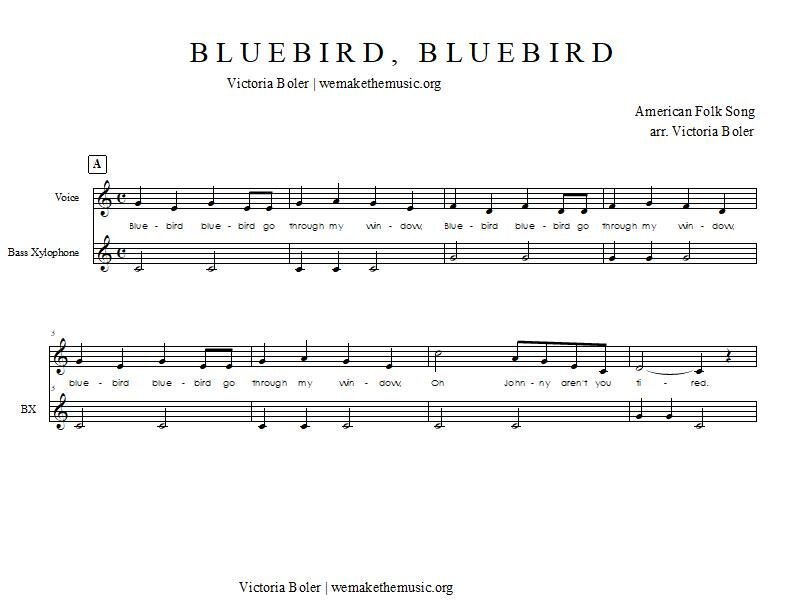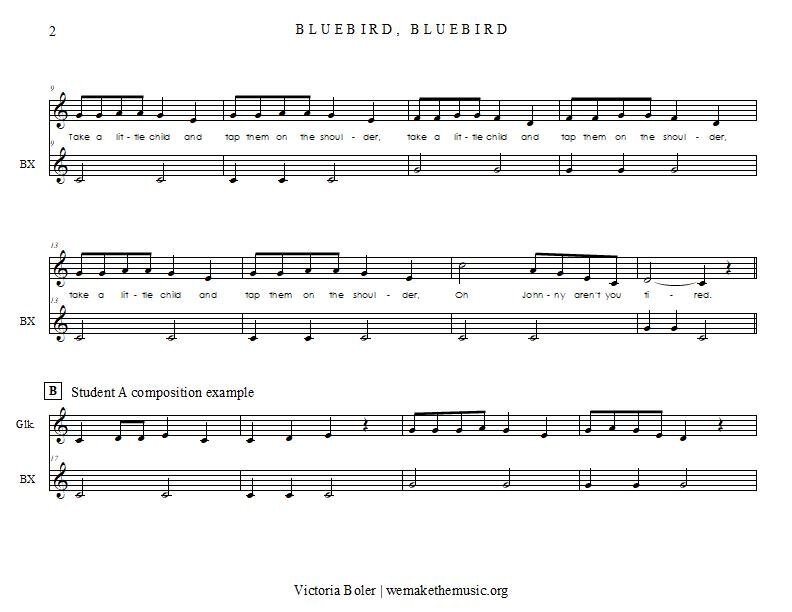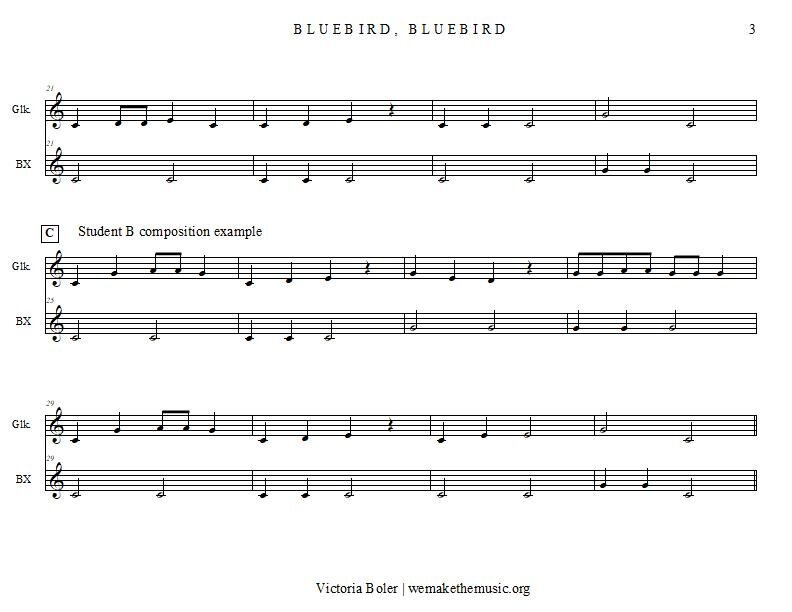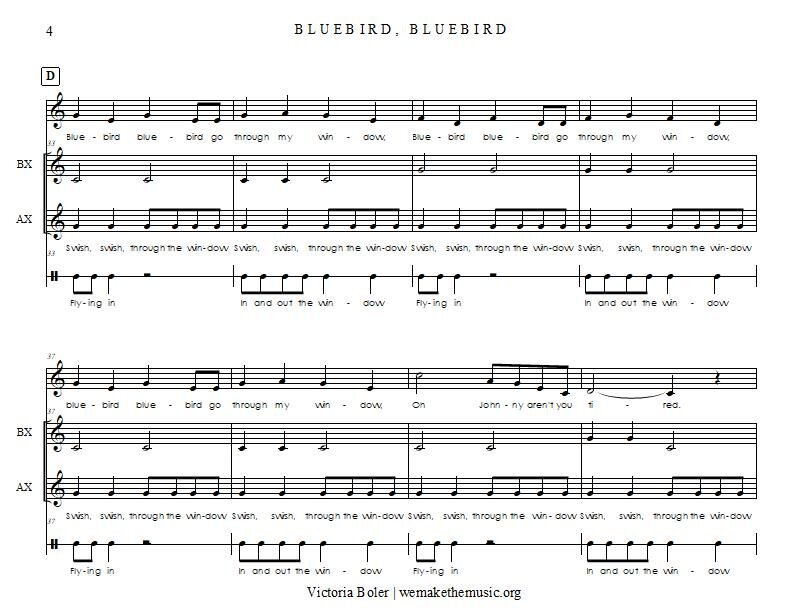An Orff Arrangement for Bluebird Bluebird
When we refer to an “Orff arrangement,” we typically mean that the song or rhyme uses barred instruments. However, that may not be all there is to making something “Orff.”
What Makes it Orff?
The Orff approach is a play-based process that centers around student choice and creativity. Simply using an “Orff instrument” may not necessarily mean that the students are using the instrument to expand their musical knowledge in a way that puts the learner’s needs first.
How teachers apply this philosophy can look very different from classroom to classroom. However, there are a few things we can expect to see in an Orff-inspired approach:
Mixed media: students speak, play instruments, sing, and move to express musicality.
Musical Choice: The teacher gives an amount of control over the musical elements in a piece. For example, students might improvise or arrange a section, create movements, decide the musical form, or choose instrumentation.
Collaboration: Though individuality is celebrated in the Orff philosophy, students also spend a lot of time working in small groups or making musical decisions as a large ensemble. Every voice is valued!
Here’s an example of how the Orff approach can be used with the song, Bluebird Bluebird. All the resources for this arrangement (the score, worksheets, and visuals) are available as a free download.
Getting Started:
Previous Knowledge and Skills:
Students will have the most success with this arrangement if they have the following concepts and skills already in place:
Knowledge: steady beat, rhythm, rhythm vs beat, ta and ta-di, ta rest, half notes, sol and mi, la, do, and re.
Skills: pitch matching, barred instrument techniques, auxiliary percussion techniques, improvisation, arranging, dictation, rhythmic and melodic reading
In my curriculum, this combination of knowledge and skills happens at the end of 2nd grade, or the beginning of 3rd grade.
You can read more about my curriculum outline here, and get the templates for your own classroom in The Planning Binder.
Musical Objective:
The goal of the arrangement is for students to compose with the full pentatonic scale. This score has several musical elements happening at once. However, everything could be taken out except the song and glockenspiel, and the objective would still be accomplished.
The Score:
Here is the full score.
You can get the score below, along with all the other resources for this arrangement!
Breaking it Down:
This song is made of a main melody, a harmonic outline, two ostinati, and student compositions.
Process these parts however works best for your situation! If you’d like a starting point, I’ve included some ways my students have found success with these elements.
Melody: The song and the game
This is the version of the game I use:
Students stand in a circle with their hands above their heads to form “windows.” One student is the bluebird. The bluebird flies in and out the student windows while the rest of the class sings the song.
At each “take a little partner,” the bluebird taps the closest student on the shoulder. The three students follow behind the bluebird and the game begins again. Each repetition of the song, the head bluebird chooses three more students until the whole class is in the bluebird line.
Harmony: Bass xylophone
Since students have knowledge about do as the “home” pitch, they are ready to play the bass xylophone part.
Using the idea of “home” and “away,” students play the tonic and dominant pitches. This image of birds flying away and coming back home is helpful to reinforce the harmonic concepts.
I would also have the class help me transfer it to standard notation after students have played the progression a few times.
Process:
As with any mallet part, it’s a good idea to consider starting the learning process with body percussion. Students can stomp for tonic and snap for dominant.
We’ll use this same body percussion designation in the composition process too. It helps to spiral concepts through a variety of different uses!
Ostinati: Alto xylophone and tubano
I tend to teach these parts aurally, and use the notation as a reference in later lessons.
Choosing Instruments: The Orff Arrangement Sound Pyramid
I chose alto xylophone instead of soprano because in the sound pyramid for this ensemble, we don’t need much more treble apart from the glockenspiel. By the same reasoning, the tubano sound will add more low frequencies to balance out the piece.
Student-Created Ostinati
Students can also come up with their own ostinati based on the text! Most of the time each student comes up with some ideas, and then we share out as a class.
When I notice a pattern that will work with the existing rhythms, I casually verbalize my decision of the pattern we’ll use (speaking the rhythmic syllables of the pattern, not the name of the student who created it).
Composition: Glockenspiel
In a nutshell, this glockenspiel part is the whole purpose of the arrangement. It is also the part of the process that really makes it “Orff!”
I chose glockenspiel because the high pitched, ringing sound seems the most bird-like. I also like that the glockenspiel timbre and register cuts through the rest of the ensemble.
Process:
The composition involves a few more steps than the other elements. Here is how I prefer to approach this sequence:
Step 1: As with most mallet parts, we begin with body percussion.
With a partner, students create rhythmic compositions and arrange them for body percussion. All the rhythmic compositions will end the same way to add a more unifying structure.
As they think about their body percussion assignments, they follow notation on the board. This is a simplified version of the bass part. Using it as a guide will ensure that their glockenspiel melodies work smoothly with the harmonic progression.
The only requirement is that students play the first beat of each measure on the designated note (either “home” or “away”). This enforces the physical sensation of their rhythms and the harmonic progression, even if they don’t necessarily correspond to all the pitches they will use on barred instruments!
Step 2: Students “place their rhythms” on barred instruments.
I like to do this part individually, but it can also be done with a partner if you don’t have enough barred instruments.
As students compose, they should play the instrument first, find a pattern they like, and THEN write it down so they can remember it later. I discourage students from writing letter names on the worksheet at random and then trying to figure out how to play their composition. That approach is sure to lead to awkward intervals that are difficult to play.
Step 3: Editing.
Any composer, writer, teacher, designer, engineer, or coder knows that great final products go through editing. In this case, students should make sure their final composition is easy to play, that it matches the harmonic outline on the worksheet, and that they like how it sounds. A simple step to help the editing process is for students to write on the back of the paper what they accomplished in that class period and what they plan to do next class. The prompt is, “Today I _____ (the student writes what they worked on). Next class I will _______(the student writes the next steps)__.” This helps everyone stay on track as the lesson progresses through several weekly segments.
Putting it all together:
This song is written in ternary form. However, it could easily be adapted to rondo form if you want to give more students the chance to share their compositions.
The coda is very simple. It extends the rhythm of the last subphrase (Oh Johnny aren’t you tired), and brings back the opening subphrase (bluebird bluebird go through my window) along with the two ostinati.
Closing tips:
Every Orff-inspired teacher applies the Orff philosophy in different ways. That said, here are some tried-and-true tips for working with an Orff arrangement like this one.
Start with singing. Start with the singing game.
All students learn all the parts.
Put instrumental parts on body percussion before instruments.
Add new elements in slowly.
Keep it fun! This is musically dense, but still a play-based process.















